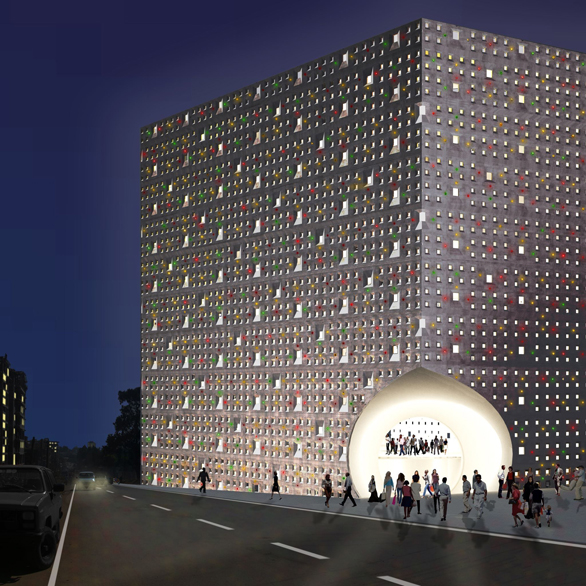
A nighttime view of the Lideta Mercato, an unconventional shopping mall in Ethiopia designed with local traditions in mind. Image: Xavier Vilalta
If you look closely at the Lideta Mercato — a shopping mall in Addis Ababa, Ethiopia, designed by TED Fellow Xavier Vilalta — you will notice a unique pattern on its skin, inspired by the beautiful, bold patterns found on Ethiopian women’s dresses. But if you look closer, you will also notice something else: that the design is based on fractal geometry.
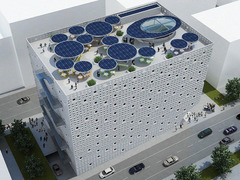 Xavier Vilalta: Architecture at home in its community
In today’s talk, Vilalta shares that when he first was approached about designing this mall, his instinct was “to run away.” He hated the idea of building a big, Western-inspired mall that was generally empty because no one could afford the shops, that needed tons of energy to cool because its glass façade trapped the heat, and that took no inspiration whatsoever from Ethiopian traditions around it. In this talk, Vilalta shares how he approached this design, which is currently in the process of being built, by making the mall more like an Ethiopian open-air market with small shops. Rather than glass walls, he used concrete blocks with square cutouts to create a textile-like façade that would allow cross-ventilation.
Xavier Vilalta: Architecture at home in its community
In today’s talk, Vilalta shares that when he first was approached about designing this mall, his instinct was “to run away.” He hated the idea of building a big, Western-inspired mall that was generally empty because no one could afford the shops, that needed tons of energy to cool because its glass façade trapped the heat, and that took no inspiration whatsoever from Ethiopian traditions around it. In this talk, Vilalta shares how he approached this design, which is currently in the process of being built, by making the mall more like an Ethiopian open-air market with small shops. Rather than glass walls, he used concrete blocks with square cutouts to create a textile-like façade that would allow cross-ventilation.
But there is one story he didn’t tell in the talk: how he recognized that the pattern of the façade needed to follow fractal geometry. For that story, we’ll need to back up several years, to 2009.
At that time, Vilalta — who lives and works in Barcelona, Spain — had a Catalan client who wanted to build a vocational school in Ethiopia, the Melaku Center. Vilalta tells the TED Blog that, because his architecture is all about connecting buildings to the nature and culture around them, thinking about this project was a challenge. “It was the first time I was operating in an environment that was not like mine,” he said. “Trying to relate the project to the site, I had to really understand a whole new culture.”
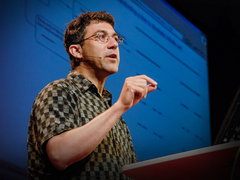 Ron Eglash: The fractals at the heart of African designs
He began doing tons of research on design, architecture and culture in Ethiopia and nearby African countries. And he happened upon a book: Ron Eglash’s African Fractals. Entranced, he watched Eglash’s TED Talk, “The fractals at the heart of African design,” and kept on reading about how fractals — mathematical, recursive patterns that explain the geometry of nature, with smaller parts mirroring larger parts — also form the basis for the layout of African villages and the patterns that appear in African art.
Ron Eglash: The fractals at the heart of African designs
He began doing tons of research on design, architecture and culture in Ethiopia and nearby African countries. And he happened upon a book: Ron Eglash’s African Fractals. Entranced, he watched Eglash’s TED Talk, “The fractals at the heart of African design,” and kept on reading about how fractals — mathematical, recursive patterns that explain the geometry of nature, with smaller parts mirroring larger parts — also form the basis for the layout of African villages and the patterns that appear in African art.
Vilalta was fascinated.
“I found it extremely interesting, this scientific way of looking at African art and architecture. That was a whole new discovery for me,” says Vilalta. “This opened new possibilities in terms of architectural design. Thinking with fractals and geometry in designs was like a complete new world.”
Vilalta designed the Melaku Center campus — which is as big as three square blocks in Barcelona — on a fractal-based hexagonal grid, creating smaller communities within the school. Classrooms, workshops, administration buildings, a library, living spaces, dining spaces, a health care center, a supermarket and more were laid out in a scalar, circular mesh. Once the design was completed, Vilalta reached out to Eglash with an email. It struck up a working friendship that exists to this day.
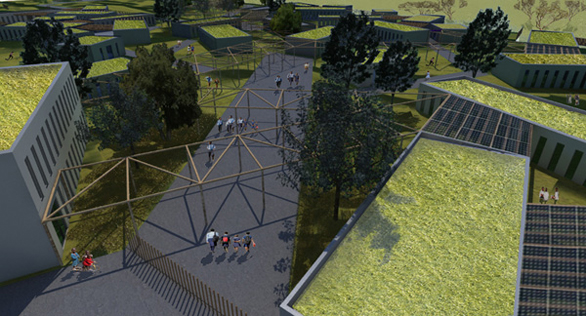
And a rendering of the campus. Image: Xavier Vilalta
Eglash tells the TED Blog, “I get a lot of inquiries, some of them pretty off the wall – hate mail from neo-Nazis, or strange declarations from mystics. Xavier’s email, on the other hand, was the kind you actually want to get.”
After a few correspondences, Eglash mentioned the TED Fellows program to Vilalta, as he had met several TED Fellows while giving his talk at TEDGlobal 2007. Eglash says, “[The Fellows] had a terrific combination of creative energy and practical skills. I knew [Xavier] would fit right in.”
At Eglash’s prompting, Vilalta decided to apply. He joined the TED Fellows class of 2011.
But Eglash’s influence didn’t stop there. Later, when Vilalta was commissioned to design a master plan for a university in Angola, he used fractal geometry again to place each building. And in the Lideta Mercato in Ethiopia, he used fractal design as a means of enclosure.
“The fractal geometry is a part of the design of the façade, it’s done with the same patterns as Ethiopian women’s dresses,” explains Vilalta. “These fractal geometries are used as something that people can relate to, as something of their own culture. But at the same time as something that has function. It’s for ventilating and lighting the building too.”
Eglash gives this new work the thumbs up.
“The Lideta Mercato design is beautiful, of course, but for me it is especially satisfying to see how [Xavier] has managed to nurture the fractal tradition from Africa into this new form, and help the next generation carry that into the future,” says Eglash. “It’s more than just aesthetics: the scaling structure provides a practical means of providing airflow and improving the building’s ecological fit.”
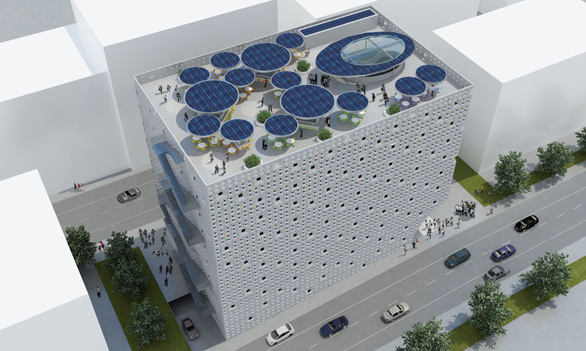
Another view of the Lieta Mercato. Notice: the very cool outdoor gathering space on the roof.
Sure, people walking past the building are unlikely to say, “Oh look, the façade uses fractal geometry.” But the design does strike an unconscious chord. Vilalta tells a story that illustrates this.
“This building is now getting finished, and I saw someone standing in front of the billboard there in the construction site with his wife and pointing to the billboard, and pointing to his wife, and saying, ‘Look, this is like your dress,’” he says. “For me it’s like, ‘Okay, they understood.’ The architecture needs to belong to people, you know? … When people make it theirs, that’s when it feels good.”
Watch Vilalta’s talk for more on the Lideta Mercato and on the biggest project he has ever taken on, an apartment complex called “Le Grand Tapis” in Tunis, Tunisia, which has a truly amazing park on the roof. Watch Eglash’s talk to understand much more about what fractals are and how they underpin African art, design and architecture. And in the TEDxMadrid talk below, hear more about how fractals have infused Vilalta’s work. (English speakers, just turn the closed captioning subtitles on.)
Comments (28)
Pingback: Africa: Heritage Algorithms Combine the Rigors of Science With the Infinite Possibilities of Art and Design - Time Africa
Pingback: 遗产算法将科学的严谨性与艺术和设计的无限可能性结合起来 - Mandarinian
Pingback: Heritage algorithms combine the rigors of science with the infinite possibilities of art and design - Vip News Today
Pingback: Heritage algorithms combine the rigors of science with the infinite possibilities of art and design
Pingback: Heritage algorithms combine the rigors of science with the infinite possibilities of art and design - AVR News
Pingback: Heritage algorithms combine the rigors of science with the infinite possibilities of art and design - Super Daily News
Pingback: Heritage algorithms combine the rigors of science with the infinite possibilities of art and design -
Pingback: Africa: Heritage Algorithms Combine the Rigors of Science With the Infinite Possibilities of Art and Design – East Africa Today
Pingback: Heritage algorithms combine the rigors of science with the infinite possibilities of art and design - News Azi
Pingback: Heritage algorithms combine the rigors of science with the infinite possibilities of art and design - NFL Bulletin
Pingback: Heritage algorithms combine the rigors of science with the infinite possibilities of art and design - Q'Hubo News
Pingback: Heritage algorithms combine the rigors of science with the infinite possibilities of art and design - Quick Telecast
Pingback: Legit Dragon Pharma - roids.blog
Pingback: Ron Eglash's fractal patterns expertise makes an impact on Detroit students | UM Detroit - UMich - Newszhub
Pingback: Buy Steroids with Bitcoins
Pingback: On Intellectual Courage and Accountability, Ron Eglash « Social Epistemology Review and Reply Collective
Pingback: “Every line means something” | Boom For Real Bamako
Pingback: | Cyber Ethiopia
Pingback: Xavier Vilalta: Architecture at Home in Its Community « AddisEthiopia Weblog